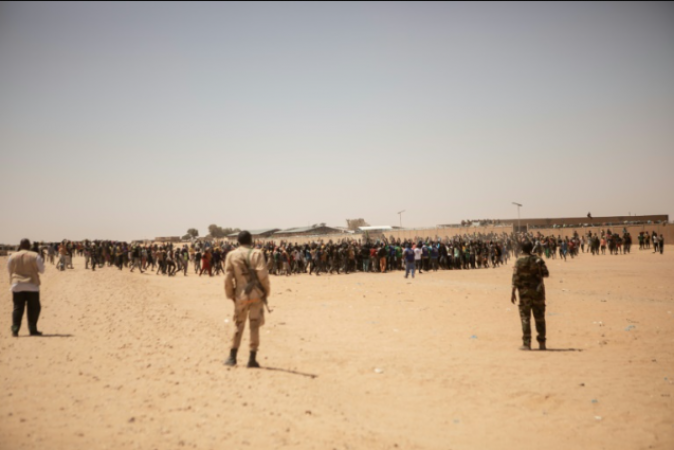
Assamaka: In the northern Niger desert, a long line of people can be seen moving in silhouette. At the front are the sturdy walkers. the back is the weakest.
Assamaka, the first village on the Niger border, is where hundreds more migrants who were expelled from Algeria end up every week. More than 4,500 of them—mostly Malians, Guineans, and Ivorians, but also Syrians and even Bangladeshis—have so far washed up in this remote, windswept area of the Sahara.
After marching across 15 km of wasteland, they finally arrived in a new purgatory.
Also Read: "Love Jihad" in Britain too? Home Minister says Pakistanis stalk white girls
Only about one-third of arrivals are handled by a transit centre run by the UN's International Organization for Migration.
Abdoul Karim Bambara from the Ivory Coast stated, "When we got here, we were told we weren't recognised as migrants by the IOM, so we had to pay for our own transport to return home.
The water tanks in Assamaka are almost empty, the food rations are inadequate, and there is a lack of shade from the scorching sun. Thousands of people seek cover behind walls or under tarpaulins in temperatures that can approach 48 degrees Celsius (118 degrees Fahrenheit).
The migrants claim that in Algeria, the first step towards a hoped-for new life in Europe, they were robbed of their possessions.
Even calling family members is too expensive for them to afford. Sometimes for months at a time, they are marooned in the desert in an open prison. Doctors, students, and traders are among their number who are intelligent and talented.
But as a tense crowd of desperate people gathers around the barbed-wire walls of the IOM compound, pushing and shoving in visceral despair, individual characteristics are forgotten.
Also Read: Pakistan desperate for food grains during Ramadan, yet secretly sending flour to Afghanistan!
Herman, an Ivorian as well, stated that "we have turned into cattle." Many of the migrants are physically ill, scabies-infected, or have wounds that are infected. Everyone is peckish. One man pointed to a lump of fly-infested sticky rice and asked, "You saw that?" Do you want to eat that? We are becoming ill as a result.
In a dust cloud, two groups of ravenous men are throwing stones at one another. Fights frequently occur. After a Cameroonian died, there was a riot that was put down with tear gas a few days earlier. The protesters vandalised the IOM centre.
"We have all suffered trauma. There is nothing here; people are losing their minds, they are unable to control themselves. "People are dying," yelled Sierra Leonean Aboubacar Cherif Cisse.
People wouldn't fight if there was enough to eat, but since there isn't any, what can they do? They will fight each other to survive if they have nothing, according to Mohamed Mambu, who represents Sierra Leoneans at a different transit centre 200 kilometres away in Arlit.
The migrant situation is overwhelming for Assamaka's 1,500 residents. Francois Ibrahim, who works for the NGO Alarme Phone Sahara, which aids migrants stranded in the desert, claimed that they are spread out throughout the village, close to the health centre, and by the walls.
Ibrahim claimed that the immigrants rob locals of their animals and kill them for food.
Since the beginning of the year, more migrants have been forced into Niger, creating a "unprecedented situation," according to the French charity MSF, which is also known as Doctors without Borders.
Agadez, the capital of the region of Niger, is 350 kilometres from Assamaka and has a third transit facility, but all three are overcrowded. Due to armed jihadist groups' threat to the roads leading south, migrants must be flown out on charter flights for their safety.
Ousmane Atair, a manager at the Arlit centre, claimed that although "the flights are frequently cancelled," individuals are still expelled from Algeria on a weekly basis.
Convoys led by IOM subcontractors transport migrants by road from Assamaka to Arlit and then on to Agadez. The cost of the area's relative stability appears to be becoming apparent.
Also Read US rejects NATO's "roadmap" for Ukraine
According to Abdourahamane Maouli, mayor of Arlit, "The road from Assamaka to Arlit is the best protected and that's why the migration flow heads this way."
The EU has taken over as the main source of funding for the IOM in the region as a result of the rising demand for international aid and its desire to deter migration.
Alarme Phone Sahara stated that "the IOM plays a key role in the policy of EU states to externalise their borders to African territory."
After the Libyan crisis erupted in 2011, Agadez became the "last gateway" to Europe, according to Tari Dogo, secretary of the regional council, but the EU had failed to take decisive action to stem the migrant flow. This situation is partly the fault of the European Union, he said.